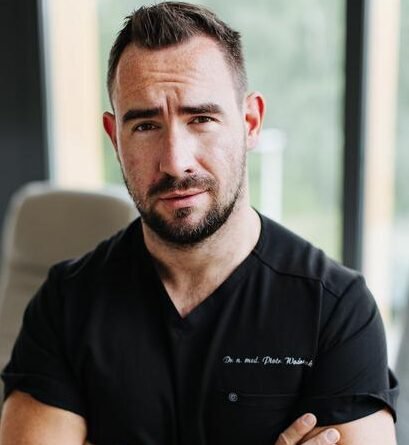Dry Eyes Often Diagnosed Late With Lasting Consequences
They say that the eyes are the mirror of the soul, but when they become dry, tired, and irritated, that look loses its clarity.
The U.S study and the multinational NESTS study reveal that more than half of adults experience dry eye symptoms, yet few receive proper care, often enduring daily discomfort and ineffective treatments for years. The findings presented at the 43rd Congress of the European Society for Cataract and Refractive Surgery (ESCRS), held in Copenhagen in September 2025, show that dry eye is a global problem affecting more than half of the world’s population.
ESCRS was founded in 1991 to promote education and research in implant and refractive surgery and to advance ophthalmology as a whole. Today, it brings together more than 7,500 members from 130 countries. Its history began in 1981, when the European Intraocular Implant Club was founded, which eventually evolved into today’s ESCRS.
The main goal of the studies was to assess the prevalence of dry eye, its impact on individuals, and how it is perceived, whether self-diagnosed or diagnosed by a physician, starting with adults in the United States. The objectives included evaluating the impact of symptoms on daily life, reviewing treatment approaches and interactions with eye care and healthcare professionals, and identifying different groups of people based on their treatment needs, satisfaction, and preferences. The U.S. study was conducted through 10-minute online surveys in April 2024 and included 2,003 adults.
The multinational study, titled Needs Unmet in Dry Eye: Symptoms, Treatment and Severity (NESTS), was conducted by Bausch and Lomb in two phases during 2025 in the United Kingdom, France, Germany, Poland, and Saudi Arabia, involving over 5,000 participants (2,580 adults in the general population and 2,572 dry eye sufferers). Eligible participants were identified via a screening questionnaire and provided informed consent.
The results
The results were presented by Dr. Piotr Wozniak, a refractive surgeon and dry eye specialist at Optegra Eye Clinics in Warsaw, Poland, and a lecturer and clinical instructor at Cardinal Stefan Wyszyński University in Warsaw. Dr. Wozniak is also one of the authors of a notable study published in 2020, which describes a rare case of cowpox in a man’s upper eyelid, leading to severe ocular complications and requiring multiple surgeries.
The results show that more than half of the population in the US and Europe has dry eye, with a diagnosis rate of 17% in the USA and 20% in Europe. The NESTS study found that 58% of people experience dry eye symptoms, yet only one in five are diagnosed by a healthcare professional, even though half report symptoms daily. A worrying finding was that one-third of patients waited more than five years before seeking help. Due to dry eye symptoms, patients stopped driving at night or reduced their use of air conditioning.
Many patients also felt that their treatments were ineffective; specifically, only 25% believed their treatment had helped. In a press release, Dr. Wozniak said that in France, fewer than half of people with dry eye had scheduled follow-up appointments, while in Saudi Arabia, the majority (84%) were proactively monitored by their doctors. The U.S study showed that as many as 70% of people were unaware of available treatment options, and 40% did not know that untreated dry eye can lead to other problems, such as vision loss.
Tears are not just water; they contain enzymes and proteins that protect the eyes from infection and oxidative damage. In addition to keeping the surface of the eye hydrated, tears support natural defense mechanisms and help maintain healthy vision.
“What I’d emphasize is this: don’t just reach for any drop at the pharmacy. If symptoms persist, see an eye specialist. Proper diagnosis is key, because dry eye is not one disease – it has many forms, and the right treatment must be tailored to the cause.”
People often take painkillers for headaches but pay little attention to eye health. How do dry eyes affect enzymes like lysozyme, and what are the consequences? With so many eye drops available, how can people choose the best one, and what happens when they use them without consulting a doctor?
Dr. Wozniak: Dry eye doesn’t just mean a lack of comfort – it changes the biochemistry of the tear film and the eye surface. Normally, tears contain protective molecules: lysozyme helps fight bacteria, glutathione-related enzymes protect against oxidative stress, and enzymes like PDE6 are important for normal retinal signaling. In chronic dry eye, the concentration and activity of these protective molecules drop. This makes the eye more vulnerable to infections, oxidative damage, and even functional changes over time. So the consequences go beyond burning or redness – they can affect long-term eye health.
When it comes to drops, there are indeed countless options. The best choice depends on the type of dry eye – for example, whether it’s more about inflammation, meibomian gland dysfunction, or aqueous deficiency. Some drops contain lipids to reduce evaporation, others have electrolytes and osmoprotectants to restore balance, and some even contain vitamin A for healing. If people self-prescribe without guidance, they may use the wrong type – or, in severe cases, mask the problem while it silently progresses. What I’d emphasize is this: don’t just reach for any drop at the pharmacy. If symptoms persist, see an eye specialist. Proper diagnosis is key, because dry eye is not one disease – it has many forms, and the right treatment must be tailored to the cause.
Choosing the right eye drops always begins with a detailed history and examination, including ocular surface health and meibography, because dry eye is not a single disease but a spectrum of conditions. That’s why there is no one-size-fits-all answer. Beyond simple lubricants, we also have anti-inflammatory treatments such as steroids and cyclosporine, as well as newer options like water-free drops or LFA-1 antagonists (lifitegrast). In more advanced cases, we can use procedures such as IPL, LipiFlow, punctal plugs, or serum drops.
“SS affects approximately 0.06% of the world’s population, with women accounting for more than 90% of those affected. It has been reported that 10% of patients with dry eye disease (DED) have SS, but unfortunately, two-thirds of these cases are undiagnosed, with a median delay of 10 years to diagnosis.”
Dry eyes are also one of the key symptoms of autoimmune conditions such as Sjögren’s syndrome, which typically causes dry eyes, dry mouth, and other systemic issues as well.
Dr. Wozniak: SS affects approximately 0.06% of the world’s population, with women accounting for more than 90% of those affected. It has been reported that 10% of patients with dry eye disease (DED) have SS, but unfortunately, two-thirds of these cases are undiagnosed, with a median delay of 10 years to diagnosis. This underdiagnosis can be attributed to several factors, including the high prevalence of dry eye and dry mouth, the nonspecific clinical manifestations of SS, and the insidious onset of the disease.
In addition, patients with SSDE may be asymptomatic or only mildly symptomatic despite significant ocular inflammation. Furthermore, there are few reliable and effective screening tools and algorithms to determine which DED patients should be worked for SS. Physicians may also underestimate the severity of SS’s effect on quality of life and, thus, refer few patients for workup. The pathogenesis of SS involves both genetic susceptibility and environmental exposure.
Although the exact etiology is unknown, the pathogenesis of primary SSDE can be divided into four steps. First is the interaction between genetic susceptibility and environmental exposure. This may trigger the second step: development of autoimmunity. The third step is the destruction of lacrimal glands, resulting in aqueous tear deficiency. Fourth is the dysfunction of the entire functional lacrimal unit, ultimately leading to a vicious cycle of DED. In the final stage, differentiating SSDE from other types of dry eye is challenging for clinicians. This is due to overlapping symptoms with general dry eye and the extensive damage to the lacrimal unit in SSDE, which is similar to other severe dry eye diseases.
According to the data, the global eye health supplement market was estimated at $1.95 billion in 2024 and is projected to reach $2.94 billion by 2030. However, our eyes are exposed to many influences, including the impact of climate change. Research shows that climate change affects eye health, especially the ocular surface, and that better understanding and mitigation of these impacts require global collaboration between high- and low-income countries. The results of the study from Brazil highlight how much more research is needed. The first home-based study in Brazil included 420 urban and 180 rural households in the southeast of the country, where volunteers over the age of 40 completed the Short Dry Eye Questionnaire. The results showed that dry eye symptoms are more common in urban areas and among women, and that dry eye in Brazil has different risk factors and a high prevalence.
“Dry eye is not just discomfort — it’s a chronic condition that can be prevented or slowed if you take care of your overall health and truly nourish the eyes from the inside and outside.”
Altogether, the evidence points to the need for a broader, more comprehensive perspective.
”Artificial tears are helpful for quick relief, but they don’t address the deeper problem. Nourishing the eyes means supporting the glands, cells, and tear film that keep the surface healthy. A balanced diet rich in omega-3 fatty acids and antioxidants, good hydration, and a healthy indoor environment (rule 20/20/20, full blinking) can all reduce inflammation and strengthen natural tear production. At night, protective ointments or gels — sometimes with vitamin A — can support regeneration during sleep. So, prevention is not only about drops but also about caring for the whole system: lifestyle, diet, sleep, and environment. What I’d emphasize to people is that dry eye is not just discomfort — it’s a chronic condition that can be prevented or slowed if you take care of your overall health and truly nourish the eyes from the inside and outside,” concluded Dr. Wozniak.


